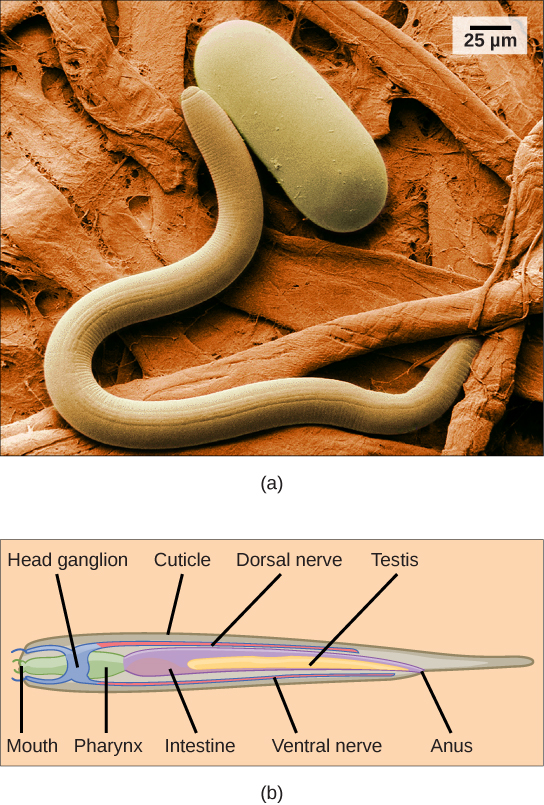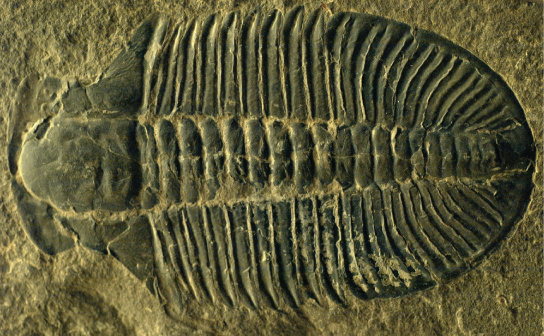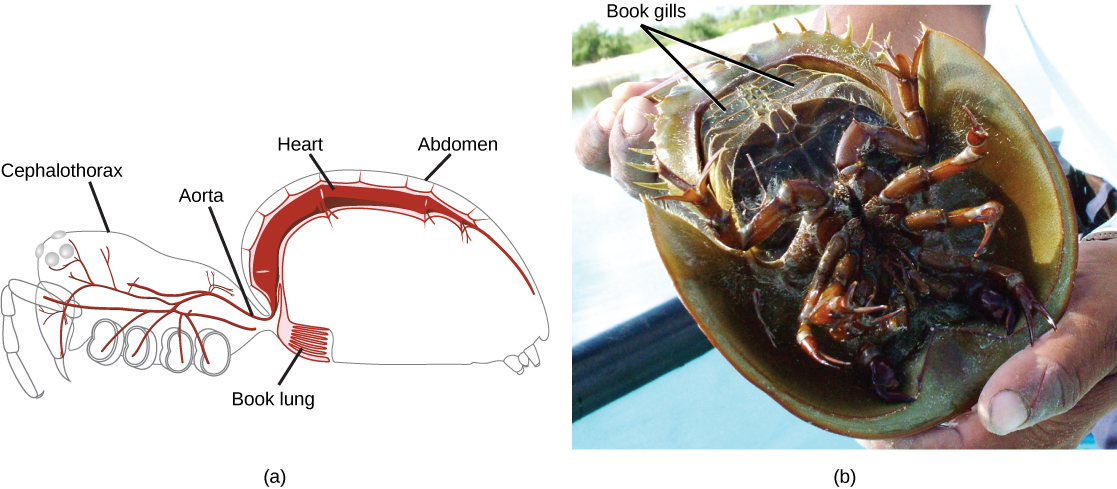| << Chapter < Page | Chapter >> Page > |
The phylum Nematoda , or roundworms, includes more than 28,000 species with an estimated 16,000 parasitic species. The name Nematoda is derived from the Greek word “nemos,” which means “thread.” Nematodes are present in all habitats and are extremely common, although they are usually not visible ( [link] ).

Most nematodes look similar to each other: slender tubes, tapered at each end ( [link] ). Nematodes are pseudocoelomates and have a complete digestive system with a distinct mouth and anus.
The nematode body is encased in a cuticle, a flexible but tough exoskeleton, or external skeleton, which offers protection and support. The cuticle contains a carbohydrate-protein polymer called chitin. The cuticle also lines the pharynx and rectum. Although the exoskeleton provides protection, it restricts growth, and therefore must be continually shed and replaced as the animal increases in size.
A nematode’s mouth opens at the anterior end with three or six lips and, in some species, teeth in the form of cuticular extensions. There may also be a sharp stylet that can protrude from the mouth to stab prey or pierce plant or animal cells. The mouth leads to a muscular pharynx and intestine, leading to the rectum and anal opening at the posterior end.
In nematodes, the excretory system is not specialized. Nitrogenous wastes are removed by diffusion. In marine nematodes, regulation of water and salt is achieved by specialized glands that remove unwanted ions while maintaining internal body fluid concentrations.
Most nematodes have four nerve cords that run along the length of the body on the top, bottom, and sides. The nerve cords fuse in a ring around the pharynx, to form a head ganglion or “brain” of the worm, as well as at the posterior end to form the tail ganglion. Beneath the epidermis lies a layer of longitudinal muscles that permits only side-to-side, wave-like undulation of the body.
Nematodes employ a diversity of sexual reproductive strategies depending on the species; they may be monoecious, dioecious (separate sexes), or may reproduce asexually by parthenogenesis. Caenorhabditis elegans is nearly unique among animals in having both self-fertilizing hermaphrodites and a male sex that can mate with the hermaphrodite.
The name of this phylum, “ Arthropoda ” means “jointed legs,” which aptly describes each of the enormous number of species belonging to this phylum. An estimated 85 percent of known species belong to this phylum, with many more still undiscovered or undescribed. Insects form the largest single group within the phylum. The principal characteristics of all the animals in this phylum are functional segmentation of the body and the presence of jointed appendages ( [link] ). Arthropods also have an exoskeleton made principally of chitin. Arthropods are true coelomate animals and exhibit protostomic development.

A unique feature of arthropods is the presence of a segmented body with fusion of certain sets of segments to give rise to functional segments. Fused segments may form a head, thorax, and abdomen, or a cephalothorax and abdomen, or a head and trunk. The coelom takes the form of a hemocoel (or blood cavity). The open circulatory system, in which blood bathes the internal organs rather than circulating in vessels, is powered by a two-chambered heart. Respiratory systems vary, depending on the group of arthropod: Insects and myriapods use a series of tubes (tracheae) that branch throughout the body, open to the outside through openings called spiracles, and perform gas exchange directly between the cells and air in the tracheae. Aquatic crustaceans use gills, arachnids employ “book lungs,” and aquatic chelicerates use “book gills.” The book lungs of arachnids are internal stacks of alternating air pockets and hemocoel tissue shaped like the pages of a book. The book gills of crustaceans are external structures similar to book lungs with stacks of leaf-like structures that exchange gases with the surrounding water ( [link] ).

Phylum Arthropoda includes animals that have been successful in colonizing terrestrial, aquatic, and aerial habitats. The phylum is further classified into five subphyla: Trilobitomorpha (trilobites), Hexapoda (insects and relatives), Myriapoda (millipedes, centipedes, and relatives), Crustacea (crabs, lobsters, crayfish, isopods, barnacles, and some zooplankton), and Chelicerata (horseshoe crabs, arachnids, scorpions, and daddy longlegs). Trilobites are an extinct group of arthropods found from the Cambrian period (540–490 million years ago) until they became extinct in the Permian (300–251 million years ago) that are probably most closely related to the Chelicerata. The 17,000 described species have been identified from fossils ( [link] ).


Notification Switch
Would you like to follow the 'Principles of biology' conversation and receive update notifications?